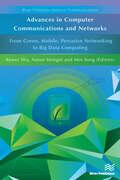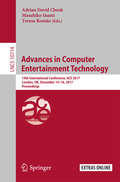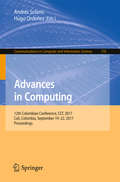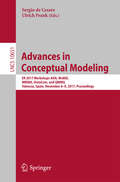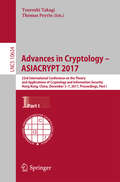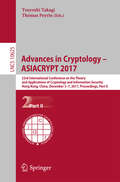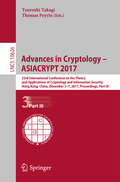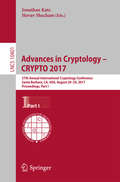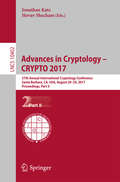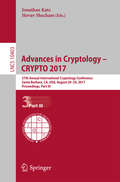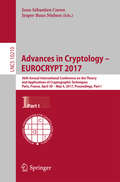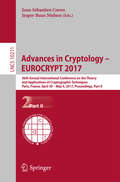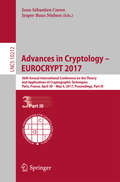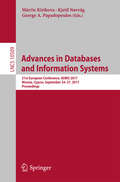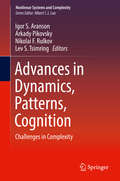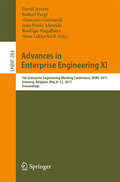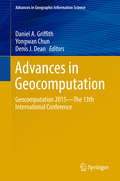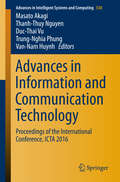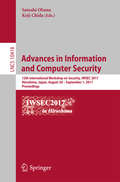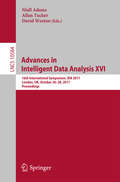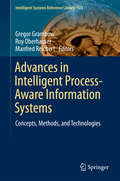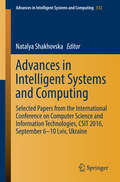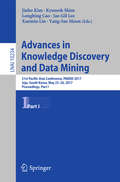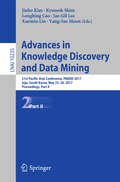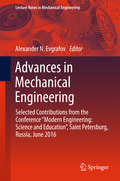- Table View
- List View
Advances in Computer Communications and Networks From Green, Mobile, Pervasive Networking to Big Data Computing
by Min Song Kewei Sha Aaron StriegelRecent developments in computer communications and networks have enabled the deployment of exciting new areas such as Internet of Things and collaborative big data analysis. The design and implementation of energy efficient future generation communication and networking technologies also require the clever research and development of mobile, pervasive, and large-scale computing technologies. Advances in Computer Communications and Networks: from Green, Mobile, Pervasive Networking to Big Data Computing studies and presents recent advances in communication and networking technologies reflecting the state-of-the-art research achievements in novel communication technology and network optimization. Technical topics discussed in the book include: Data Center NetworksMobile Ad Hoc NetworksMultimedia NetworksInternet of ThingsWireless SpectrumNetwork Optimization.This book is ideal for personnel in computer communication and networking industries as well as academic staff and collegial, master, Ph.D. students in computer science, computer engineering, electrical engineering and telecommunication systems.
Advances in Computer Entertainment Technology: 14th International Conference, Ace 2017, London, Uk, December 14-16, 2017, Proceedings (Lecture Notes in Computer Science #10714)
by Adrian David Cheok Teresa Romão Masahiko InamiThis book constitutes the refereed conference proceedings of the 14th International Conference on Advances in Computer Entertainment Technology, ACE 2017, held in London, UK, in December 2017. <P><P> The 59 full papers presented were selected from a total of 229 submissions. <P><P> ACE is by nature a multi-disciplinary conference, therefore attracting people across a wide spectrum of interests and disciplines including computer science, design, arts, sociology, anthropology, psychology, and marketing. The main goal is to stimulate discussion in the development of new and compelling entertainment computing and interactive art concepts and applications.
Advances in Computing: 12th Colombian Conference, CCC 2017, Cali, Colombia, September 19-22, 2017, Proceedings (Communications in Computer and Information Science #735)
by Andrés Solano Hugo OrdoñezThis book constitutes the refereed proceedings of the 12th Colombian Conference on Computing, CCC 2017, held in Cali, Colombia, in September 2017. <P><P> The 56 revised full papers presented were carefully reviewed and selected from 186 submissions. The papers are organized in topical sections on information and knowledge management, software engineering and IT architectures, educational informatics, intelligent systems and robotics, human-computer interaction, distributed systems and large-scale architectures, image processing, computer vision and multimedia, security of the information, formal methods, computational logic and theory of computation.
Advances in Conceptual Modeling: ER 2017 Workshops AHA, MoBiD, MREBA, OntoCom, and QMMQ, Valencia, Spain, November 6–9, 2017, Proceedings (Lecture Notes in Computer Science #10651)
by Sergio de Cesare and Ulrich FrankThis book constitutes the refereed proceedings of five workshops and a symposium, held at the 36th International Conference on Conceptual Modeling, ER 2017, in Valencia, Spain in November 2017. The 21 revised full papers were carefully reviewed and selected out of 47 submissions to the following events: AHA 2017 - 3rd International Workshop on Modeling for Ambient Assistance and Healthy AgeingMoBiD 2017 - 6th International Workshop on Modeling and Management of Big DataMREBA 2017 - 4th International Workshop on Conceptual Modeling in Requirements and Business AnalysisOntoCom 2017 - 5th International Workshop on Ontologies and Conceptual ModelingQMMQ 2017 - 4th Workshop on Quality of Models and Models of Quality
Advances in Cryptology – ASIACRYPT 2017: 23rd International Conference on the Theory and Applications of Cryptology and Information Security, Hong Kong, China, December 3-7, 2017, Proceedings, Part I (Lecture Notes in Computer Science #10624)
by Tsuyoshi Takagi and Thomas PeyrinThe three-volume set LNCS 10624, 10625, 10626 constitutes the refereed proceedings of the 23rd International Conference on the Theory and Applications of Cryptology and Information Security, ASIACRYPT 2017, held in Hong Kong, China, in December 2017.The 65 revised full papers were carefully selected from 243 submissions. They are organized in topical sections on Post-Quantum Cryptography; Symmetric Key Cryptanalysis; Lattices; Homomorphic Encryptions; Access Control; Oblivious Protocols; Side Channel Analysis; Pairing-based Protocols; Quantum Algorithms; Elliptic Curves; Block Chains; Multi-Party Protocols; Operating Modes Security Proofs; Cryptographic Protocols; Foundations; Zero-Knowledge Proofs; and Symmetric Key Designs.
Advances in Cryptology – ASIACRYPT 2017: 23rd International Conference on the Theory and Applications of Cryptology and Information Security, Hong Kong, China, December 3-7, 2017, Proceedings, Part II (Lecture Notes in Computer Science #10625)
by Tsuyoshi Takagi and Thomas PeyrinThe three-volume set LNCS 10624, 10625, 10626 constitutes the refereed proceedings of the 23rd International Conference on the Theory and Applications of Cryptology and Information Security, ASIACRYPT 2017, held in Hong Kong, China, in December 2017.The 65 revised full papers were carefully selected from 243 submissions. They are organized in topical sections on Post-Quantum Cryptography; Symmetric Key Cryptanalysis; Lattices; Homomorphic Encryptions; Access Control; Oblivious Protocols; Side Channel Analysis; Pairing-based Protocols; Quantum Algorithms; Elliptic Curves; Block Chains; Multi-Party Protocols; Operating Modes Security Proofs; Cryptographic Protocols; Foundations; Zero-Knowledge Proofs; and Symmetric Key Designs.
Advances in Cryptology – ASIACRYPT 2017: 23rd International Conference on the Theory and Applications of Cryptology and Information Security, Hong Kong, China, December 3-7, 2017, Proceedings, Part III (Lecture Notes in Computer Science #10626)
by Tsuyoshi Takagi Thomas PeyrinThe three-volume set LNCS 10624, 10625, 10626 constitutes the refereed proceedings of the 23rd International Conference on the Theory and Applications of Cryptology and Information Security, ASIACRYPT 2017, held in Hong Kong, China, in December 2017.The 65 revised full papers were carefully selected from 243 submissions. They are organized in topical sections on Post-Quantum Cryptography; Symmetric Key Cryptanalysis; Lattices; Homomorphic Encryptions; Access Control; Oblivious Protocols; Side Channel Analysis; Pairing-based Protocols; Quantum Algorithms; Elliptic Curves; Block Chains; Multi-Party Protocols; Operating Modes Security Proofs; Cryptographic Protocols; Foundations; Zero-Knowledge Proofs; and Symmetric Key Designs.
Advances in Cryptology – CRYPTO 2017: 37th Annual International Cryptology Conference, Santa Barbara, CA, USA, August 20–24, 2017, Proceedings, Part I (Lecture Notes in Computer Science #10401)
by Jonathan Katz Hovav ShachamThe three volume-set, LNCS 10401, LNCS 10402, and LNCS 10403, constitutes the refereed proceedings of the 37th Annual International Cryptology Conference, CRYPTO 2017, held in Santa Barbara, CA, USA, in August 2017. The 72 revised full papers presented were carefully reviewed and selected from 311 submissions. The papers are organized in the following topical sections: functional encryption; foundations; two-party computation; bitcoin; multiparty computation; award papers; obfuscation; conditional disclosure of secrets; OT and ORAM; quantum; hash functions; lattices; signatures; block ciphers; authenticated encryption; public-key encryption, stream ciphers, lattice crypto; leakage and subversion; symmetric-key crypto, and real-world crypto.
Advances in Cryptology – CRYPTO 2017: 37th Annual International Cryptology Conference, Santa Barbara, CA, USA, August 20–24, 2017, Proceedings, Part II (Lecture Notes in Computer Science #10402)
by Jonathan Katz and Hovav ShachamThe three volume-set, LNCS 10401, LNCS 10402, and LNCS 10403, constitutes the refereed proceedings of the 37th Annual International Cryptology Conference, CRYPTO 2017, held in Santa Barbara, CA, USA, in August 2017.The 72 revised full papers presented were carefully reviewed and selected from 311 submissions. The papers are organized in the following topical sections: functional encryption; foundations; two-party computation; bitcoin; multiparty computation; award papers; obfuscation; conditional disclosure of secrets; OT and ORAM; quantum; hash functions; lattices; signatures; block ciphers; authenticated encryption; public-key encryption, stream ciphers, lattice crypto; leakage and subversion; symmetric-key crypto, and real-world crypto.
Advances in Cryptology – CRYPTO 2017: 37th Annual International Cryptology Conference, Santa Barbara, CA, USA, August 20–24, 2017, Proceedings, Part III (Lecture Notes in Computer Science #10403)
by Jonathan Katz and Hovav ShachamThe three volume-set, LNCS 10401, LNCS 10402, and LNCS 10403, constitutes the refereed proceedings of the 37th Annual International Cryptology Conference, CRYPTO 2017, held in Santa Barbara, CA, USA, in August 2017.The 72 revised full papers presented were carefully reviewed and selected from 311 submissions. The papers are organized in the following topical sections: functional encryption; foundations; two-party computation; bitcoin; multiparty computation; award papers; obfuscation; conditional disclosure of secrets; OT and ORAM; quantum; hash functions; lattices; signatures; block ciphers; authenticated encryption; public-key encryption, stream ciphers, lattice crypto; leakage and subversion; symmetric-key crypto, and real-world crypto.
Advances in Cryptology – EUROCRYPT 2017: 36th Annual International Conference on the Theory and Applications of Cryptographic Techniques, Paris, France, April 30 – May 4, 2017, Proceedings, Part I (Lecture Notes in Computer Science #10210)
by Jesper Buus Nielsen Jean-Sébastien CoronThe three-volume proceedings LNCS 10210-10212 constitute the thoroughly refereed proceedings of the 36th Annual International Conference on the Theory and Applications of Cryptographic Techniques, EUROCRYPT 2017, held in Paris, France, in April/May 2017. The 67 full papers included in these volumes were carefully reviewed and selected from 264 submissions. The papers are organized in topical sections named: lattice attacks and constructions; obfuscation and functional encryption; discrete logarithm; multiparty computation; universal composability; zero knowledge; side-channel attacks and countermeasures; functional encryption; elliptic curves; symmetric cryptanalysis; provable security for symmetric cryptography; security models; blockchain; memory hard functions; symmetric-key constructions; obfuscation; quantum cryptography; public-key encryption and key-exchange.
Advances in Cryptology – EUROCRYPT 2017: 36th Annual International Conference on the Theory and Applications of Cryptographic Techniques, Paris, France, April 30 – May 4, 2017, Proceedings, Part II (Lecture Notes in Computer Science #10211)
by Jesper Buus Nielsen Jean-Sébastien CoronThe three-volume proceedings LNCS 10210-10212 constitute the thoroughly refereed proceedings of the 36th Annual International Conference on the Theory and Applications of Cryptographic Techniques, EUROCRYPT 2017, held in Paris, France, in April/May 2017. The 67 full papers included in these volumes were carefully reviewed and selected from 264 submissions. The papers are organized in topical sections named: lattice attacks and constructions; obfuscation and functional encryption; discrete logarithm; multiparty computation; universal composability; zero knowledge; side-channel attacks and countermeasures; functional encryption; elliptic curves; symmetric cryptanalysis; provable security for symmetric cryptography; security models; blockchain; memory hard functions; symmetric-key constructions; obfuscation; quantum cryptography; public-key encryption and key-exchange.
Advances in Cryptology – EUROCRYPT 2017: 36th Annual International Conference on the Theory and Applications of Cryptographic Techniques, Paris, France, April 30 – May 4, 2017, Proceedings, Part III (Lecture Notes in Computer Science #10212)
by Jesper Buus Nielsen Jean-Sébastien CoronThe three-volume proceedings LNCS 10210-10212 constitute the thoroughly refereed proceedings of the 36th Annual International Conference on the Theory and Applications of Cryptographic Techniques, EUROCRYPT 2017, held in Paris, France, in April/May 2017. The 67 full papers included in these volumes were carefully reviewed and selected from 264 submissions. The papers are organized in topical sections named: lattice attacks and constructions; obfuscation and functional encryption; discrete logarithm; multiparty computation; universal composability; zero knowledge; side-channel attacks and countermeasures; functional encryption; elliptic curves; symmetric cryptanalysis; provable security for symmetric cryptography; security models; blockchain; memory hard functions; symmetric-key constructions; obfuscation; quantum cryptography; public-key encryption and key-exchange.
Advances in Databases and Information Systems: 21st European Conference, ADBIS 2017, Nicosia, Cyprus, September 24-27, 2017, Proceedings (Lecture Notes in Computer Science #10509)
by Mārīte Kirikova, Kjetil Nørvåg and George A. PapadopoulosThis book constitutes the proceedings of the 21st European Conference on Advances in Databases and Information Systems, ADBIS 2017, held in Nicosia, Cyprus, in September 2017.The 26 regular papers presented together with one keynote paper and one keynote abstract were carefully selected and reviewed from numerous submissions. The papers are organized in topical sections such as conceptual modeling and human factors; subsequence matching and streaming data; OLAP; graph databases; spatial data management; parallel and distributed data processing; query optimization, recovery, and databases on modern hardware; semantic data processing; and additional database and information systems topics.
Advances in Dynamics, Patterns, Cognition: Challenges in Complexity (Nonlinear Systems and Complexity #20)
by Arkady Pikovsky Igor S. Aranson Nikolai F. Rulkov Lev S. TsimringThis book focuses on recent progress in complexity research based on the fundamental nonlinear dynamical and statistical theory of oscillations, waves, chaos, and structures far from equilibrium. Celebrating seminal contributions to the field by Prof. M. I. Rabinovich of the University of California at San Diego, this volume brings together perspectives on both the fundamental aspects of complexity studies, as well as in applications in different fields ranging from granular patterns to understanding of the cognitive brain and mind dynamics. The slate of world-class authors review recent achievements that together present a broad and coherent coverage of modern research in complexity greater than the sum of its parts.
Advances in Enterprise Engineering XI: 7th Enterprise Engineering Working Conference, EEWC 2017, Antwerp, Belgium, May 8-12, 2017, Proceedings (Lecture Notes in Business Information Processing #284)
by David Aveiro, Robert Pergl, Giancarlo Guizzardi, João Paulo Almeida, Rodrigo Magalhães and Hans LekkerkerkThis book constitutes the proceedings of the 7th Enterprise Engineering Working Conference, EEWC 2017, held in Antwerp, Belgium, in May 2017. EEWC aims at addressing the challenges that modern and complex enterprises are facing in a rapidly changing world. The participants of the working conference share a belief that dealing with these challenges requires rigorous and scientific solutions, focusing on the design and engineering of enterprises. The goal of EEWC is to stimulate interaction between the different stakeholders, scientists as well as practitioners, interested in making Enterprise Engineering a reality.The 12 full papers and 4 short papers presented in this volume were carefully reviewed and selected from 40 submissions. They were organized in topical sections named: formalisms; standards and laws; business processes; normalized systems and evolvability; ontologies; and organization design.
Advances in Geocomputation: Geocomputation 2015--The 13th International Conference (Advances in Geographic Information Science)
by Daniel A. Griffith Yongwan Chun Denis J. DeanThis book contains refereed papers from the 13th International Conference on GeoComputation held at the University of Texas, Dallas, May 20-23, 2015. Since 1996, the members of the GeoComputation (the art and science of solving complex spatial problems with computers) community have joined together to develop a series of conferences in the United Kingdom, New Zealand, Australia, Ireland and the United States of America. The conference encourages diverse topics related to novel methodologies and technologies to enrich the future development of GeoComputation research.
Advances in Information and Communication Technology: Proceedings of the International Conference, ICTA 2016 (Advances in Intelligent Systems and Computing #538)
by Van-Nam Huynh Masato Akagi Thanh-Thuy Nguyen Duc-Thai Vu Trung-Nghia PhungThis book features papers presented at the International Conference on Advances in Information and Communication Technology (ICTA 2016), which was held in Thai Nguyen city, Vietnam, from December 1 to 13, 2016. The conference was jointly organized by Thai Nguyen University of Information and Communication Technology (ICTU), the Institute of Information Technology - Vietnam Academy of Science and Technology (IoIT), Feng Chia University, Taiwan (FCU), the Japan Advanced Institute of Science and Technology (JAIST) and the National Chung Cheng University, Taiwan (CCU) with the aim of bringing together researchers, academics, practitioners and students to not only share research results and practical applications but also to foster collaboration in information and communication technology research and education. The book includes the 66 best peer-reviewed papers, selected from the 150 submissions received.
Advances in Information and Computer Security: 12th International Workshop on Security, IWSEC 2017, Hiroshima, Japan, August 30 – September 1, 2017, Proceedings (Lecture Notes in Computer Science #10418)
by Satoshi Obana Koji ChidaThis book constitutes the refereed proceedings of the 12th International Workshop on Security, IWSEC 2017, held in Hiroshima, Japan, in August/September 2017. The 11 regular papers and 3 short papers presented in this volume were carefully reviewed and selected from 37 submissions. They were organized in topical sections named: post-quantum cryptography; system security; public key cryptosystems; cryptanalysis; and cryptographic protocols.
Advances in Intelligent Data Analysis XVI: 16th International Symposium, IDA 2017, London, UK, October 26–28, 2017, Proceedings (Lecture Notes in Computer Science #10584)
by Niall Adams, Allan Tucker and David WestonThis book constitutes the conference proceedings of the 16th International Symposium on Intelligent Data Analysis, which was held in October 2017 in London, UK.The 28 full papers presented in this book were carefully reviewed and selected from 66 submissions. The traditional focus of the IDA symposium series is on end-to-end intelligent support for data analysis. IDA solicits papers on all aspects of intelligent data analysis, including papers on intelligent support for modelling and analyzing data from complex, dynamical systems.
Advances in Intelligent Process-Aware Information Systems: Concepts, Methods, and Technologies (Intelligent Systems Reference Library #123)
by Manfred Reichert Gregor Grambow Roy OberhauserThis book provides a state-of-the-art perspective on intelligent process-aware information systems and presents chapters on specific facets and approaches applicable to such systems. Further, it highlights novel advances and developments in various aspects of intelligent process-aware information systems and business process management systems. Intelligence capabilities are increasingly being integrated into or created in many of today's software products and services. Process-aware information systems provide critical computing infrastructure to support the various processes involved in the creation and delivery of business products and services. Yet the integration of intelligence capabilities into process-aware information systems is a non-trivial yet necessary evolution of these complex systems. The book's individual chapters address adaptive process management, case management processes, autonomically-capable processes, process-oriented information logistics, process recommendations, reasoning over process models, process portability, and business process intelligence. The primary target groups are researchers and PhD/Master students in the field of information systems.
Advances in Intelligent Systems and Computing: Selected Papers from the International Conference on Computer Science and Information Technologies, CSIT 2016, September 6-10 Lviv, Ukraine (Advances in Intelligent Systems and Computing #512)
by Natalya ShakhovskaThe book reports on new theories and applications in the field of intelligent systems and computing. It covers computational and artificial intelligence methods, as well as advances in computer vision, current issue in big data and cloud computing, computation linguistics, cyber-physical systems as well as topics in intelligent information management. Written by active researchers, the different chapters are based on contributions presented at the workshop in intelligent systems and computing (ISC), held during CSIT 2016, September 6-9, and jointly organized by the Lviv Polytechnic National University, Ukraine, the Kharkiv National University of Radio Electronics, Ukraine, and the Technical University of Lodz, Poland, under patronage of Ministry of Education and Science of Ukraine. All in all, the book provides academics and professionals with extensive information and a timely snapshot of the field of intelligent systems, and it is expected to foster new discussions and collaborations among different groups.
Advances in Knowledge Discovery and Data Mining: 21st Pacific-Asia Conference, PAKDD 2017, Jeju, South Korea, May 23-26, 2017, Proceedings, Part I (Lecture Notes in Computer Science #10234)
by Jinho Kim, Kyuseok Shim, Longbing Cao, Jae-Gil Lee, Xuemin Lin and Yang-Sae MoonThis two-volume set, LNAI 10234 and 10235, constitutes the thoroughly refereed proceedings of the 21st Pacific-Asia Conference on Advances in Knowledge Discovery and Data Mining, PAKDD 2017, held in Jeju, South Korea, in May 2017. The 129 full papers were carefully reviewed and selected from 458 submissions. They are organized in topical sections named: classification and deep learning; social network and graph mining; privacy-preserving mining and security/risk applications; spatio-temporal and sequential data mining; clustering and anomaly detection; recommender system; feature selection; text and opinion mining; clustering and matrix factorization; dynamic, stream data mining; novel models and algorithms; behavioral data mining; graph clustering and community detection; dimensionality reduction.
Advances in Knowledge Discovery and Data Mining: 21st Pacific-Asia Conference, PAKDD 2017, Jeju, South Korea, May 23-26, 2017, Proceedings, Part II (Lecture Notes in Computer Science #10235)
by Jinho Kim, Kyuseok Shim, Longbing Cao, Jae-Gil Lee, Xuemin Lin and Yang-Sae MoonThis two-volume set, LNAI 10234 and 10235, constitutes the thoroughly refereed proceedings of the 21st Pacific-Asia Conference on Advances in Knowledge Discovery and Data Mining, PAKDD 2017, held in Jeju, South Korea, in May 2017. The 129 full papers were carefully reviewed and selected from 458 submissions. They are organized in topical sections named: classification and deep learning; social network and graph mining; privacy-preserving mining and security/risk applications; spatio-temporal and sequential data mining; clustering and anomaly detection; recommender system; feature selection; text and opinion mining; clustering and matrix factorization; dynamic, stream data mining; novel models and algorithms; behavioral data mining; graph clustering and community detection; dimensionality reduction.
Advances in Mechanical Engineering: Selected Contributions from the Conference “Modern Engineering: Science and Education”, Saint Petersburg, Russia, June 2016 (Lecture Notes in Mechanical Engineering)
by Alexander N. EvgrafovThis book draws together the most interesting recent results to emerge in mechanical engineering in Russia, providing a fascinating overview of the state of the art in the field in that country which will be of interest to a wide readership. A broad range of topics and issues in modern engineering are discussed, including dynamics of machines, materials engineering, structural strength and tribological behavior, transport technologies, machinery quality and innovations. The book comprises selected papers presented at the conference "Modern Engineering: Science and Education", held at the Saint Petersburg State Polytechnic University in 2016 with the support of the Russian Engineering Union. The authors are experts in various fields of engineering, and all of the papers have been carefully reviewed. The book will be of interest to mechanical engineers, lecturers in engineering disciplines and engineering graduates.
